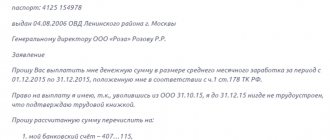Dismissal is a procedure that requires compliance with regulations from both the employee and the employer. This is connected not only with documenting the termination of the employment contract, but also with the employer’s material obligations to the employee. That is, it is necessary to make a full settlement with the employee, which includes not only wages for the time worked, but also all due compensation (for example, for unused vacation), as well as severance pay (if the reason for dismissal requires such payments).
When is severance pay paid?
Article 178 of the Labor Code implies payment of severance pay in the following cases:
- Liquidation of company;
- reduction of employees according to the updated staffing table;
- refusal of an employee to perform job duties in the event of a significant change in them and changes in working conditions;
- conscription into the army;
- illness that prevents you from continuing to work.
The amount of these payments varies from payment for two weeks to payments for three months of work.
In case of non-payment of severance pay, the employee has the right to go to court, according to which the plaintiff will be paid not only the amount due, but also compensation for the delay.
Compensation is calculated using the formula:
unpaid amount (minus personal income tax) × rate of the Central Bank of the Russian Federation (you must select the desired period, since the rate changes frequently) / 150 × number of calendar days of delay.
Waiting for a court decision is not a reason to refuse payments to an employee at all. The employer is obliged to pay the employee the amount that is “indisputable”; the rest is subject to a court decision.
Other payments upon dismissal
Upon termination of an employment contract, in accordance with the general procedure, the employer pays the employee:
- wages for days worked;
- compensation for unused days of planned annual paid leave for the entire period of work.
The employer is obliged to pay everything due on the last working day of the dismissed person; this norm is prescribed in Articles 84.1 and 140 of the Labor Code. If this does not happen, the employee has the right to demand a settlement (a sample request for dismissal can be downloaded on the Internet). After receiving the request, the employer has exactly one day to satisfy it. Otherwise, the management of the enterprise will need to pay compensation for each day of delay and bear administrative liability under Article 5.27 of the Code of Administrative Offenses (fine from 5,000 to 50,000 rubles).
And the worst defaulters face criminal liability under Article 145.1 of the Criminal Code, up to imprisonment for up to three years.
It is important to know! If the employee has a debt to the company, it is deducted from the total settlement amount.
Delay of wages
Failure to pay wages on time is a difficult situation in which many people get lost. On the one hand, layoffs seem to be the most logical solution, but on the other hand, many are afraid that the employer will not give the money back at all if they approach the situation radically. At the same time, the Labor Code clearly outlines what to do in this situation.
Article 142 of the Labor Code
The title of the article is “Employer’s liability for failure to pay wages on time.” It consists of the following provisions:
- the employer through whose fault the delay occurred is obliged to bear responsibility in accordance with the law;
- if the delay is more than 15 days, the employee can notify the boss in writing about absence from work until the debt is fully repaid;
- a citizen may not come to work at the specified time;
- during such absence, he retains his average salary;
- the employee is obliged to return to work the very next day after receiving written notification from the boss about his readiness to repay the debt.
Paragraph 2 has some exceptions, which are also stated in the article. An employee does not have the right to suspend work in the following situations:
- during martial law or a state of emergency;
- when working in the public service;
- when serving in the Armed Forces of the Russian Federation and organizations ensuring the security of the country;
- when working in emergency, search and rescue, fire or law enforcement agencies;
- when serving in organizations involved in the elimination of emergencies or natural disasters;
- when working to maintain particularly dangerous types of production or dangerous equipment;
- in services directly related to the livelihoods of the population: with water supply, heating, electricity, communications, at ambulance and emergency stations.
The law also notes that the article applies only in situations where wages are not paid at all. If the company has not transferred only part of it, the employee does not have the right not to show up for work.
Statement of failure to appear
The document can be written according to a sample or in any form. It must indicate:
- Full name of the boss in whose name the application is submitted, and full name of the employee who writes it;
- intention not to go to work (the exact date must be indicated) and reason: failure to pay wages on time;
- How many days is the payment delayed (at least 15 days);
- on the basis of which article of the Labor Code (Article 142) an employee may not show up for work;
- demand to repay debt;
- date and signature.
The employee must receive confirmation that the application has been accepted and the employer has been warned. To do this, he must hand over the paper personally to the secretariat and receive a copy with a signature and entry number.
If he is denied this, he must send the application by registered mail with notification. Upon receipt of the mail, the employee will sign the notice, which will confirm receipt of the application by the employer.
If this is not done, the boss may declare that he did not receive any document and was not notified, which will be a reason to fire the employee for absenteeism, that is, a violation of labor discipline. And although the salary will be paid upon dismissal, the citizen will no longer be able to keep his job.
How is calculation made upon dismissal?
To start the calculation process, the employee must write a statement. If this is the desire of the employee himself, and not a forced measure by the management of the enterprise, then the dismissed person is not entitled to severance pay or other additional payments.
Based on the results of consideration of the application, the manager must draw up and publish not only an order to terminate the employment relationship, but also an order on payment upon dismissal.
The accountant forms the final amount based on the salary for the period worked but not paid, and compensation for unused vacation days.
The calculation is made using the formula:
salary for the month / working days in the month × days actually worked - all deductions required by law.
Application to the labor inspectorate
The State Labor Inspectorate (SIT) is authorized to make a decision on the forced execution of the employer’s obligation to pay accrued but not paid wages on time, as well as other payments due to the employee.
The decision of the State Labor Inspectorate is an official document, and in the event of non-compliance by the employer and the expiration of the appeal period, it is sent by the labor inspectorate for execution to the bailiff service (Article 360.1 of the Labor Code of the Russian Federation, paragraph 119.1 of the Administrative Regulations, approved by Order of Rostrud dated June 13, 2019 No. 160, Art. 6.1 and 6.5 of the Law of July 21, 1997 No. 118-FZ “On Compulsory Enforcement Bodies of the Russian Federation.”)
The application to the labor inspectorate is written:
- In free form - for a written application. Indicate in it the name of the labor inspectorate where you are applying, your details, place of work, describe the circumstances of the employer’s violation of your labor rights, sign and date.
- According to a special format - when submitting an application through the website Onlineinspektsiya.rf.
To submit an application through the Onlineinspektsiya.rf website, go to the “Submit an application for violation of labor laws” section:
To do this, in the “Dismissal” subsection, you need to select the problem category “Not paid upon dismissal” and then follow the prompts on the screen:
Employer's liability in case of non-payment
Upon dismissal, payment should be made on the last working day. Otherwise, the employer will be held liable.
This may be financial liability under Article 236 of the Labor Code of the Russian Federation. In case of delay in payments, the employer is responsible for issuing money with interest in the amount of not less than 1/150 of the current key rate of the Central Bank for each day of delay. Or he faces criminal liability under Article 145.1 of the Criminal Code of the Russian Federation, which provides for partial non-payment for more than three months:
- a fine of up to 120,000 rubles or in the amount of the convicted person’s salary for a period of up to 1 year;
- or deprivation of the right to hold certain positions for a period of up to 1 year;
- or forced labor for up to 2 years;
- or imprisonment for up to 1 year.
For complete non-payment for more than two months:
- a fine of 100,000 to 500,000 rubles or in the amount of the convicted person’s salary for a period of up to 3 years;
- or forced labor for a period of up to 3 years with or without deprivation of the right to hold certain positions;
- or imprisonment for a term of up to 3 years with or without deprivation of the right to hold certain positions.
Read more: Application for street lighting in the private sector
What is included in the calculation
The final amount due to a person when he leaves his job includes:
- payment for the time actually worked;
- compensation for unfulfilled vacation;
- severance pay;
- other payments provided for by law and the employment contract (depending on the individual characteristics of each case of dismissal).
Moreover, if an employee has a debt to the company (and such cases are not so uncommon), then when calculating the calculated payments from the total amount, the amount of the debt is minus.
Debts are considered not only advances issued, but also days of rest actually not worked out, but taken towards the future vacation.
What does the document provide?
If the request was made for reasons that previously prevented the receipt of a payment on the day of dismissal (for example, with a fixed-term employment contract, when its termination occurred during the employee’s illness), the employer is obliged to satisfy the request of the former subordinate within one day from the receipt of this document.
If the demand is made due to the employee’s disagreement with the settlement payments assigned to him, then the employer must without delay pay the amount that is not disputed by him, and the remaining money will have to be discussed in the labor inspectorate or court.
In this case, in court, the former employee of the company will have the opportunity not only to demand payments in full, but also compensation for their retention.
Example situation
Termination of the employment contract falls on 07/20/2018. This day is the last working day for the specialist. The accountant prepared a package of documents and certificates that need to be issued upon dismissal, and also wrote out funds to the cash desk for processing and issuing mutual settlements. However, the employee did not show up for the money; for example, he fell ill and went to a medical institution to issue a certificate of incapacity for work. In this case, the accountant is obliged to deposit the funds that were prepared for the dismissed person into the current account. Payments must be made no later than the next day after receiving a written request from the former employee.
Features of the requirement, general points
The requirement for payment upon dismissal can be written in any form - today there is no legally established unified form.
The document can be drawn up on a simple blank sheet of paper of any suitable format (A4 is usually used). You can write it manually or type it on a computer, but with subsequent mandatory printing - this is necessary so that you can put a personal signature on the request.
It is better to make the form in two identical copies . One should be given to the employer’s representative, the second should be kept with you (after having previously obtained the signature of the company representative on it to receive a copy). You should also ensure, if possible, that the claim has been recorded in the appropriate log book.
You should be extremely careful when drawing up the document, taking into account all its nuances and subtleties, not forgetting that this form may later be useful both in the labor inspectorate and in court or in the prosecutor's office.
Read more: Agreement for real estate services for the purchase of an apartment
Application to the employer
Start with a peaceful resolution of the problem of non-payment of compensation upon dismissal. To do this, write a statement to your employer outlining the essence of your request. The application form is free:
The application can be entitled “Demand” or “Claim” so that the employer clearly responds to this document - as his responsibility under Art. 140 Labor Code of the Russian Federation.
It is better to fill out such an application/demand in two copies. Give one copy to your employer. The second one - keep it for yourself after the employer puts a stamp of receipt on it indicating the date and signature.
If a peaceful solution to the problem of paying dismissal amounts does not help, and the employer does not respond to your demands, you can directly go to court. In addition, you can try to influence the employer through a trade union body or a labor dispute commission. But not every modern company has them.
If, nevertheless, you do not want to go to court and are inclined not only to receive the money owed, but also to punish the negligent employer with unscheduled inspections and fines, you will have to write an application to other authorities. According to the law, such authorities are the labor inspectorate, the prosecutor's office, the investigative committee, and the police.
An example of drawing up an application for payment upon dismissal
The requirement has a completely standard structure and is not that difficult to compose. At the very top of the document (right or left, it doesn’t matter) it says:
- addressee - position and full name of the manager, name of the employing organization;
- Full name of the resigned employee, his passport and contact details (address and telephone number);
- date of preparation of the notification (it must coincide with the date of its submission to the interested party).
After this comes the actual demand (in the first person). Here you need to indicate:
- Full name of the applicant, his position while an employee of the enterprise, period of work in the organization and date of dismissal;
- the reason for which the demand is being made (i.e. write why the settlement payments were not received directly on the day of dismissal);
- if possible, provide some figures (for example, the amount that was accrued to the employee and the amount for which he is claiming).
It is good to support this document with links to the relevant articles of the Labor Code of the Russian Federation.
Finally, the requirement is signed and handed over to its destination.
How to make an application
Expert opinion
Polyakov Pyotr Borisovich
Lawyer with 6 years of experience. Specialization: civil law. More than 3 years of experience in drafting contracts.
Legislators have not approved a special form for such an appeal. Therefore, you will have to prepare your application in free time. However, when compiling, be guided by the following rules:
This is important to know: Filling out a work book upon dismissal: sample 2021
- The document can be handwritten or prepared using printing technology.
- In the header of the application, indicate the position and full name. the head of the employing organization, then write down the name of the institution.
- Now write down information about the applicant: full name, address, passport details.
- In the middle of the new line, enter the name of the document.
- We write the text of the document on a new line: we describe the essence of the appeal in detail. Be sure to write down the position of the dismissed person and the periods of his work in this institution. Then indicate the reason why you did not show up for the money on the appointed day, or write down a claim regarding disagreement with the amount of the estimated payment.
- List the documents that you are attaching to your application as confirmation. For example, indicate the number and date of the sick leave or the name and date of the mathematical calculation of the expected amount of payments.
- Put your handwritten signature and indicate the date the document was compiled.
Hand over the completed paper to the employer personally or hand it to his official representative. For example, give it to your secretary, HR officer or accountant.











